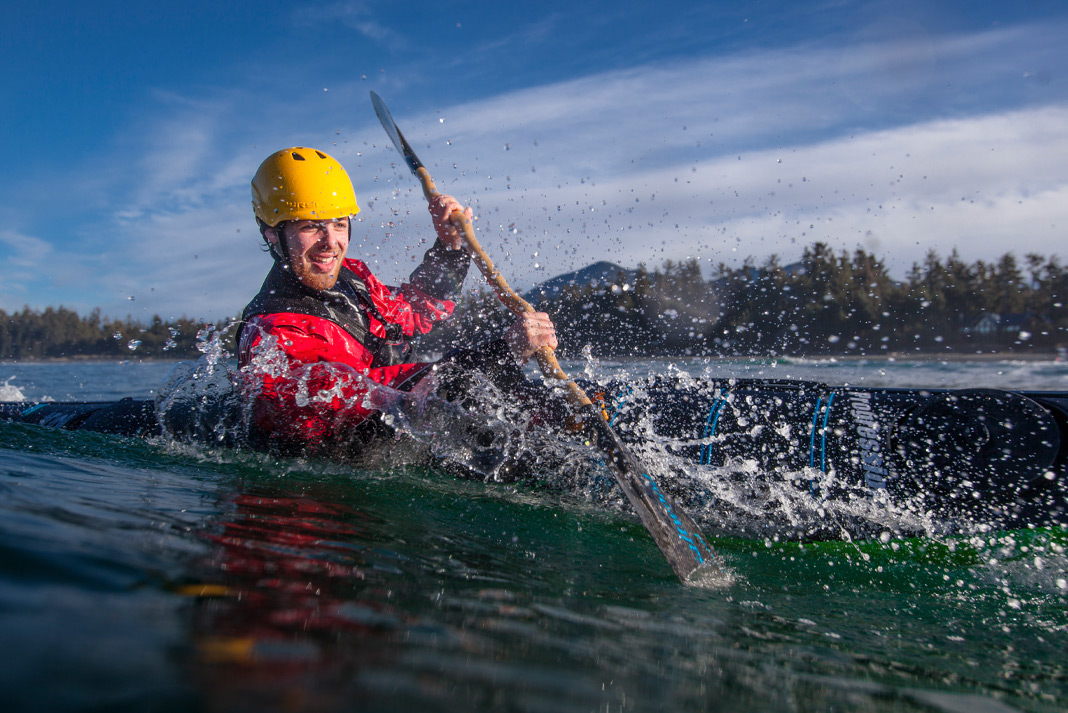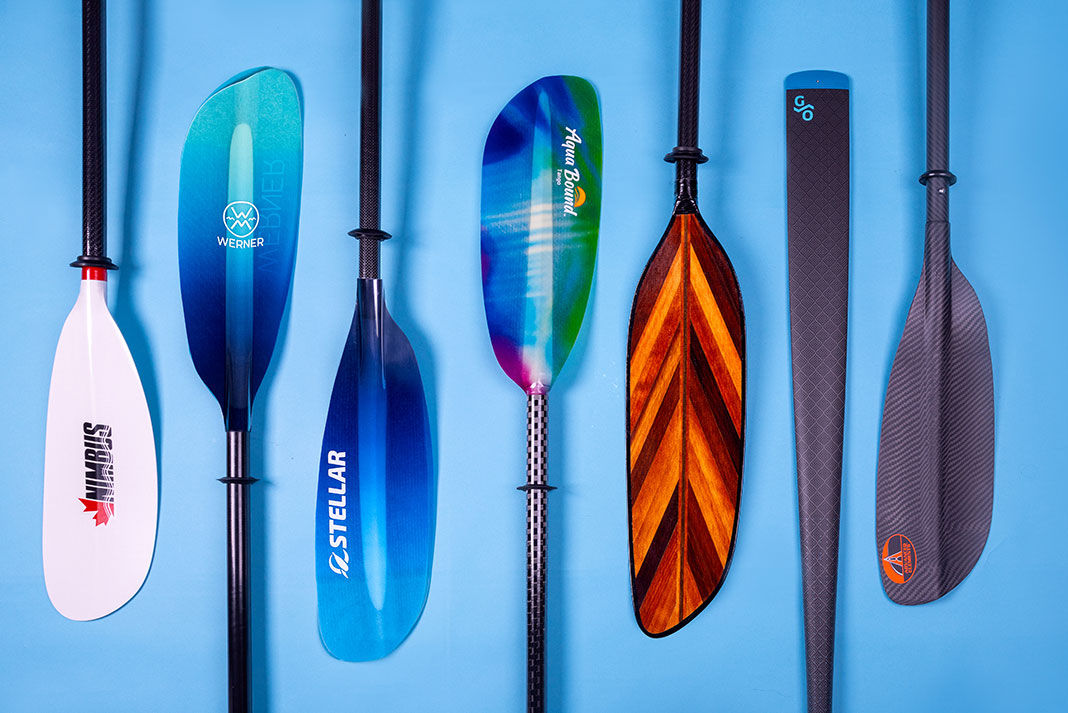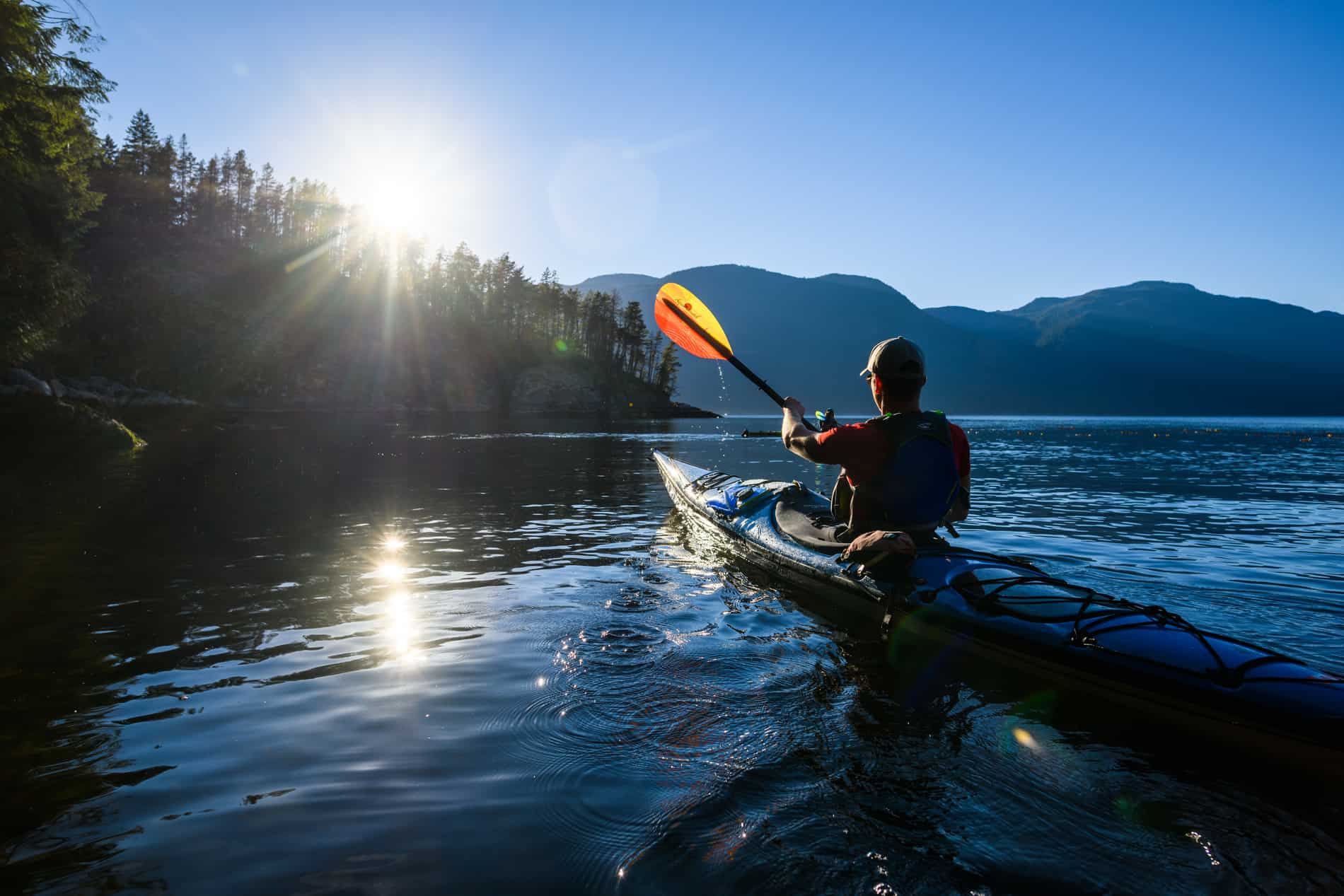Here’s a wild fact: Kayakers take thousands of strokes every hour. So while picking a kayak paddle may seem as easy as grabbing something with two blades to propel you through the water, it’s actually one of the most important pieces of gear to consider. Having the correct information to help you choose a paddle is key because if your gear doesn’t suit you it will likely end up in the corner of the garage, collecting dust with disuse because it was so uncomfortable to use.
Above all else, you want a paddle to be the right length, and along with this, the appropriate blade shape is incredibly helpful. Once you have those factors squared away, there are a number of options for the materials the paddle is made of and the construction of the shaft. To break it down, here’s a reasonable hierarchy of what to consider:
- Kayak paddle size: What length kayak paddle you choose depends largely on two factors: your height and the width of the boat.
- Paddle blade shape: This selection is nearly simultaneous with focusing on the size of the kayak paddle. Different blade shapes work best with different types of kayaks and paddling styles.
- Paddle material: Kayak paddles are made from plastics, composites, and even wood. Each has its own attributes and costs.
- Shaft construction: Most of us get into kayaking with the idea a paddle is a straight tube with two blades attached at the end. There are more options to be described below.
From blade shapes, to kayak paddle sizing and construction materials, below you’ll finder a deeper dive into all you need to help you choose.
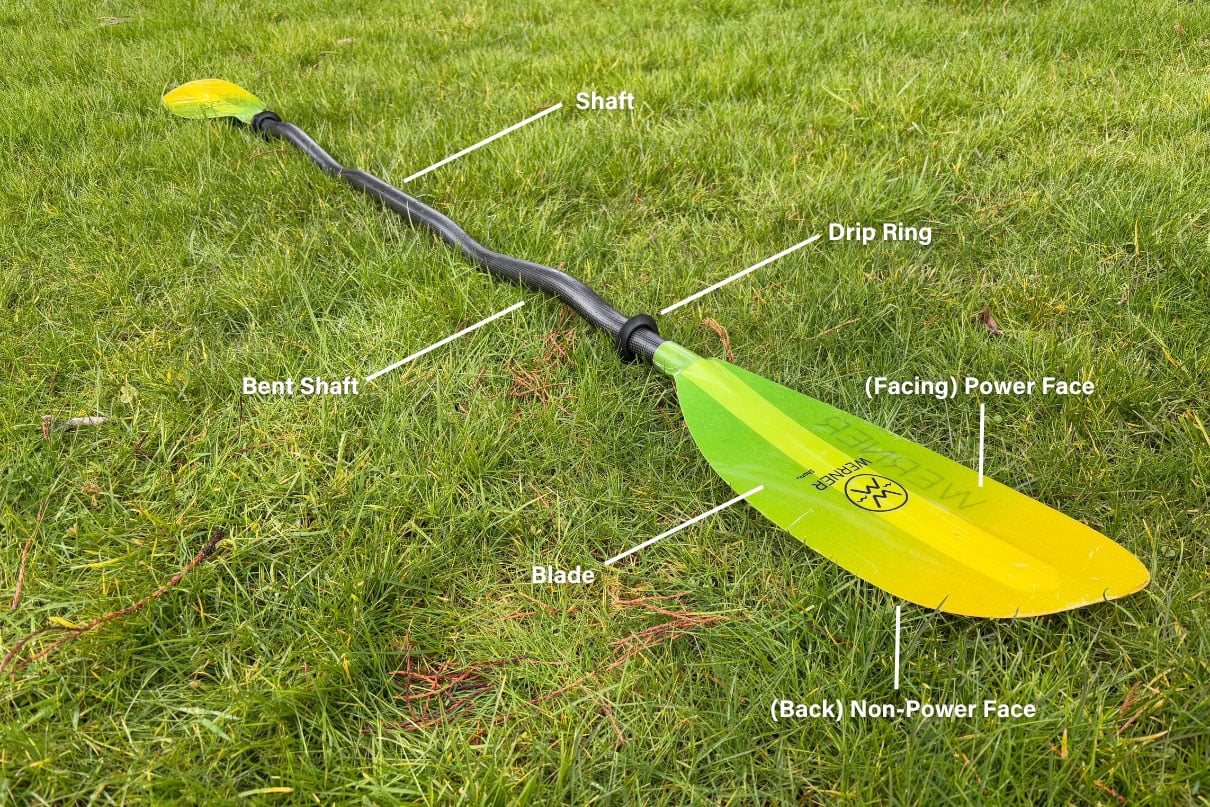
The two most important factors when deciding how to choose a kayak paddle
1 Paddle length
If you want one piece of information to walk into an outdoor store and make a pick, it is to consider what size kayak paddle to buy. This is because you want to effectively and comfortably reach the water, and this depends a great deal on the relation between the paddle length, your height, and the type of kayak you’re paddling.
For example, recreational kayaks and fishing kayaks are designed to be stable and so are often built wide, while touring kayaks are longer and narrower for more speed. A wider kayak means you’ll need a longer paddle, while for a narrower kayak, you can, and would probably prefer, a shorter paddle. Paddle length is also influenced by blade shape and vice versa, which will be covered later.
Kayak paddle size chart
The best way to figure out what size paddle you need is to follow the sizing charts of the paddle brand you are considering, such as Werner or Aqua Bound. These size recommendations, at the least, consider your height, the width of the kayak, and what style of paddle blade you’ll be using.
A paddle isn’t like a pair of shoes—there is room to use some variation when choosing a length. Once you have some experience the preference of your paddle size may change some. Overall these are the ranges you’ll be looking toward depending on kayak type and style:
- Whitewater kayakers use high-angle blades and their paddle lengths generally fall between 190 to 200 centimeters.
- Touring kayakers with a high-angle blade and boats under 25 inches wide should look toward paddle lengths between 200 and 215 centimeters. While kayaks over this width will use around a 220 to 230-centimeter paddle.
- For touring kayaks under 23 inches and a low-angle blade, you’ll want to buy a paddle between 210 and 220 centimeters.
- For touring and recreational kayaks 23 to 32-inches wide you will be looking for a paddle between 220 and 240 centimeters depending on your height.
- For recreational kayaks and fishing kayaks over 32 inches wide, and for fishing kayaks with an elevated seat, a kayak paddle will be between 240 centimeters and as much as 260 centimeters long.
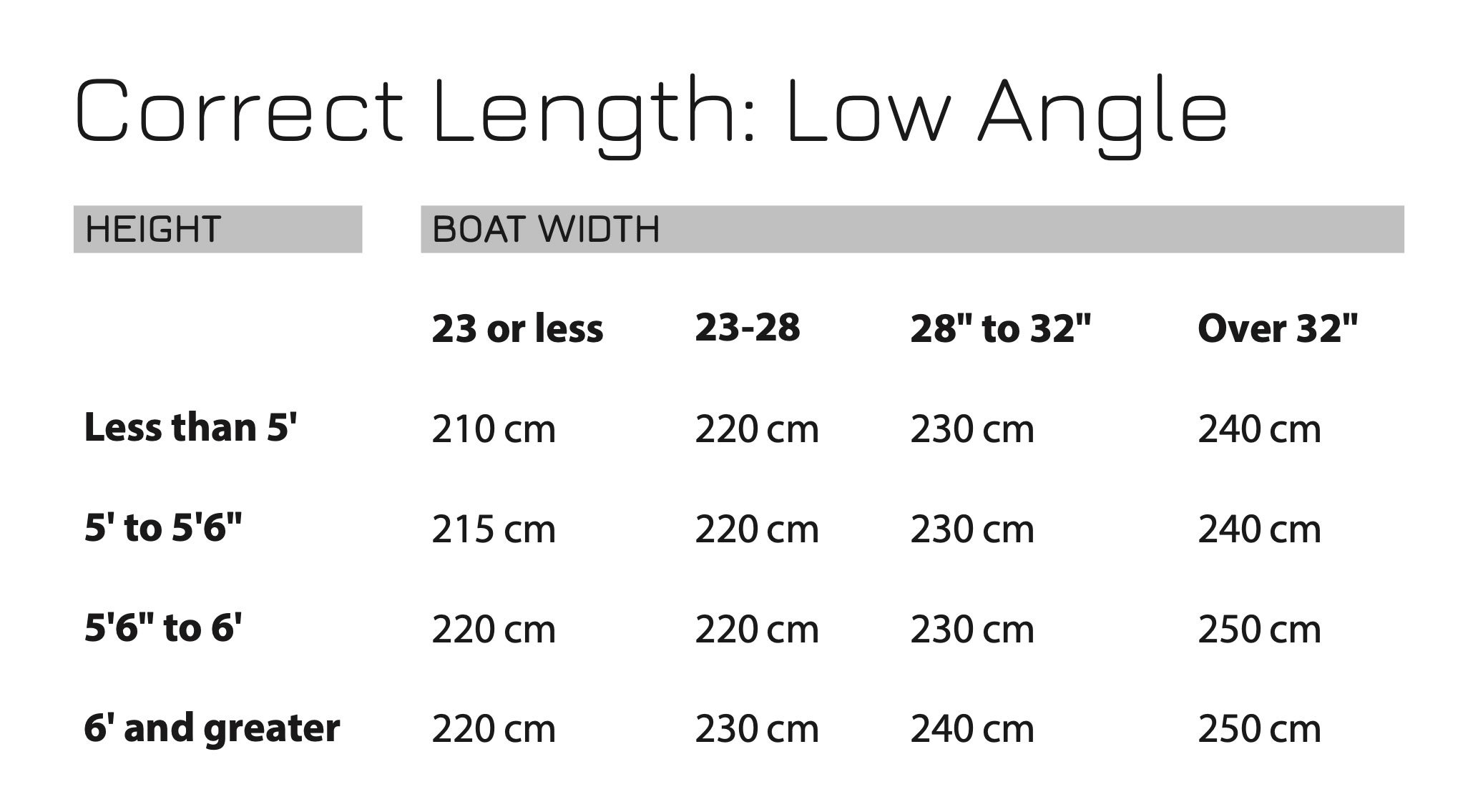
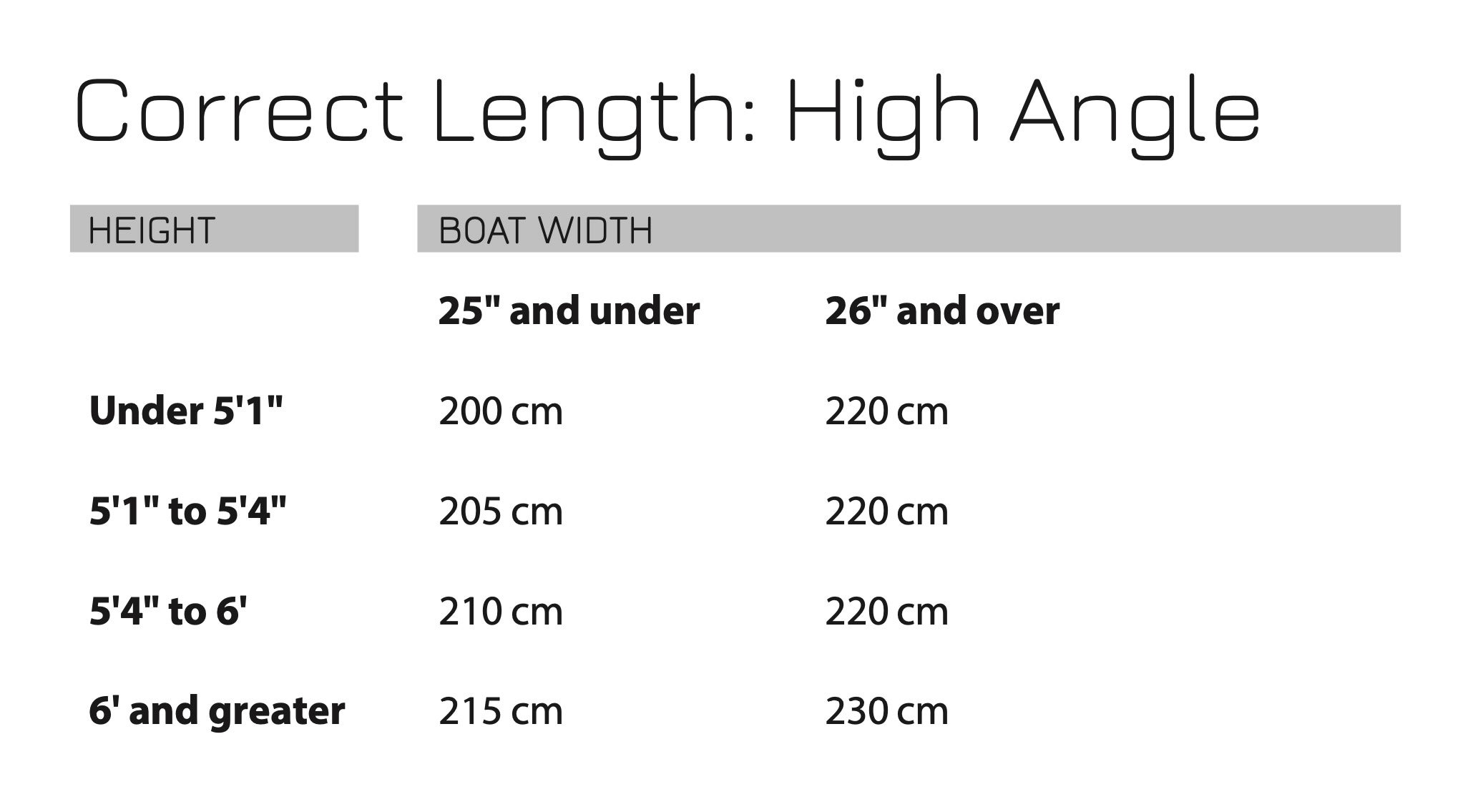
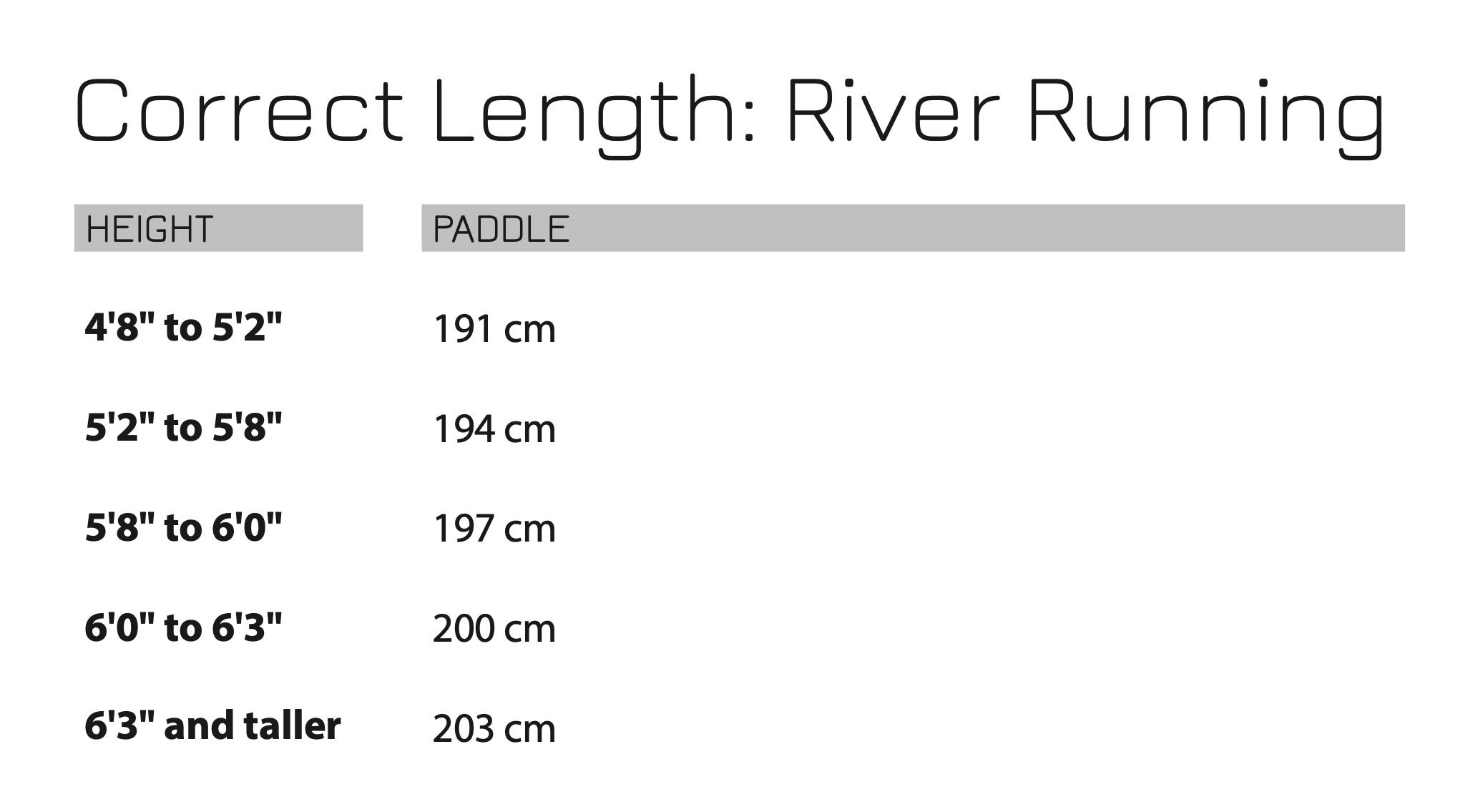
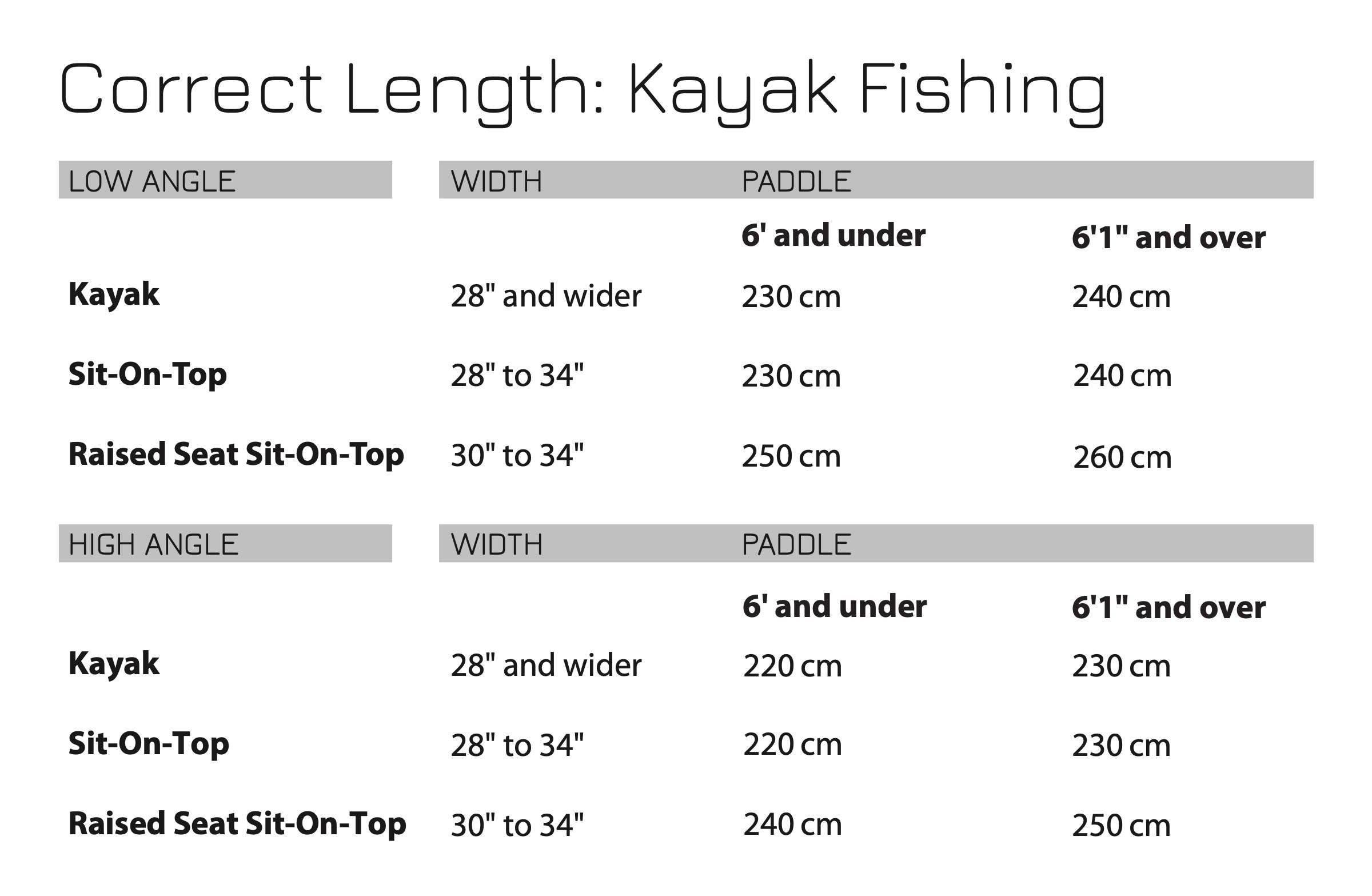
You may have noticed in the kayak paddle size charts that the paddle length not only depends on your height and the width of the kayak, but the factor of high- and low-angle paddle blades. This is something mentioned before. Different styles of paddling often call for different blade shapes and, with it, slightly different kayak paddle lengths.
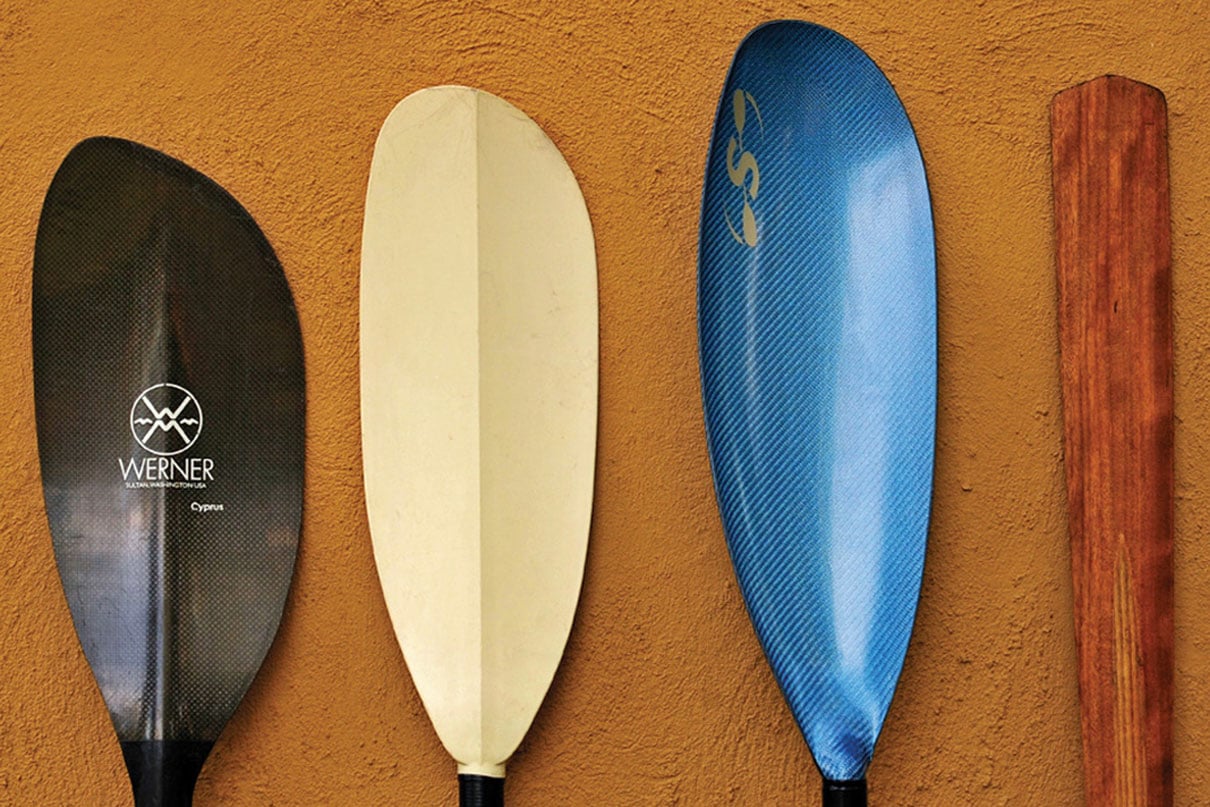
2 Paddle shape
The shape of your paddle blade is crucially important as it determines how your paddle interacts with the water during each stroke. The kind of paddling you want to do will determine the appropriate blade shape and so you want to make this consideration in concert with choosing a paddle length.
High-angle blades
If a paddle is referred to as a high-angle blade, it means the paddle is designed to be held more vertically during a forward stroke, with one hand nearly over the other. The blades on high-angle paddles are shorter and wider. They usually have more total surface area than a low-angle blade, which translates to the potential to produce more powerful strokes as you pull the power face—the slightly concave side of the blade intended to face toward you—through the water. Just as this sounds, it also requires more physical output. The blades on high-angle paddles are shorter and wider. And, if you are using a high-angle paddle, you will also use a shorter paddle length than a low-angle blade as shown in the sizing chart.
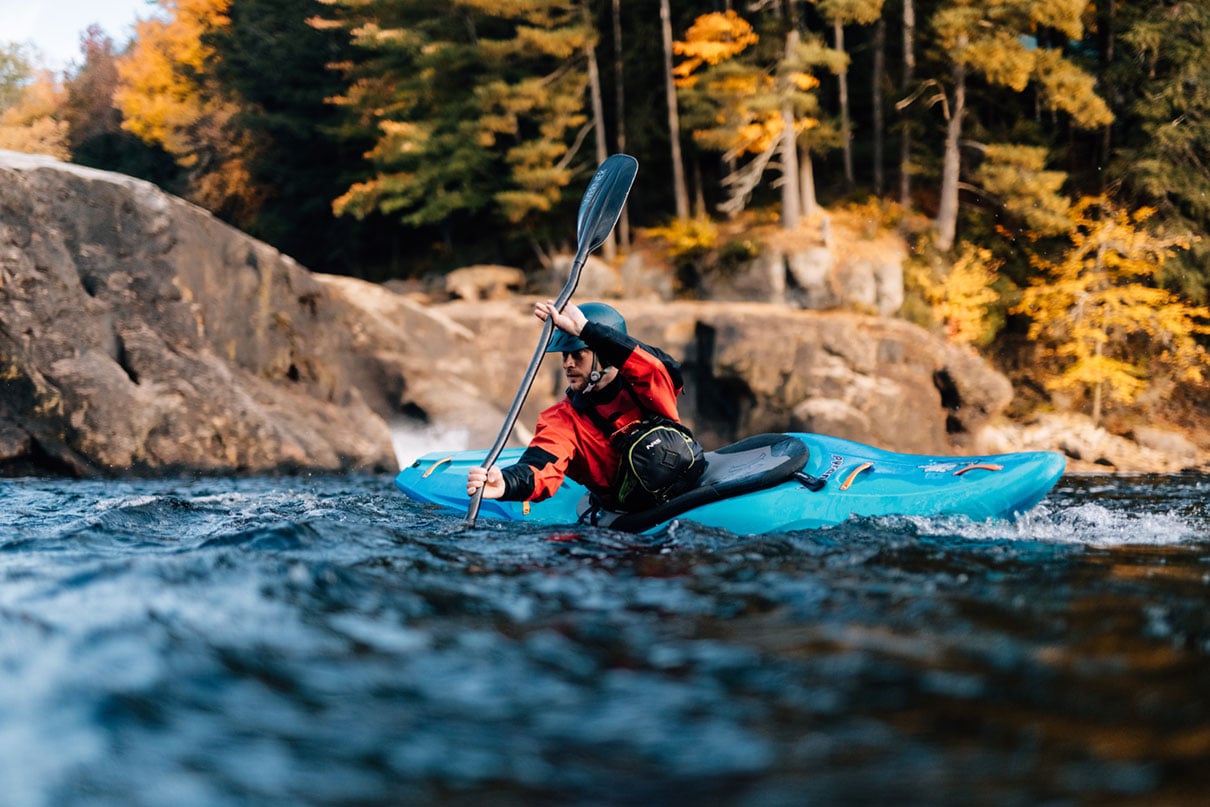
Whitewater kayak paddles are always high-angle paddle blade shapes because of the maneuvering and aggressive strokes continually used. Touring paddles can have high-angle designs or low-angle blades, depending on paddling preference and width of your boat.
However, wider kayaks, especially what are called recreational kayaks and fishing kayaks, may be uncomfortable to take these vertical paddle strokes with. Fishing kayaks are an interesting topic though. As seat heights have increased, it means a more vertical paddle stroke can be taken. Because of this, even though a longer paddle is required to reach the water, blades for fishing kayaks can have a higher-angle shape.
Low-angle blades
Blades on low-angle paddles are more elongated and skinnier. Low-angle paddling means the paddle is held more horizontally, with your hands staying below your shoulders through your strokes. The spread-out surface area of the blade provides propulsion in a more relaxed paddling style. Referencing our charts, you’ll see you will use a longer paddle when using a low-angle blade. The reasons being, to reach the water beyond the side of a wide kayak, and, the angle of entry the blade makes into the water.
Touring kayaks and wide boats such as recreational kayaks are often paired with low-angle blades.
Picture this: you are sitting low in a seat, with the side of the kayak near your elbows. Your kayak is nice and stable, with some distance between you and the water. A slightly longer paddle, with an elongated blade provides much less effort to reach the water. The stroke of a low angle paddle uses more of a sweeping motion away from the boat, which wants to turn the kayak from side to side with each stroke, but recreational and touring kayaks have a keeled shape to their hull or a rudder which counteracts most of this to help you continue going straight as you paddle.
Less common shapes
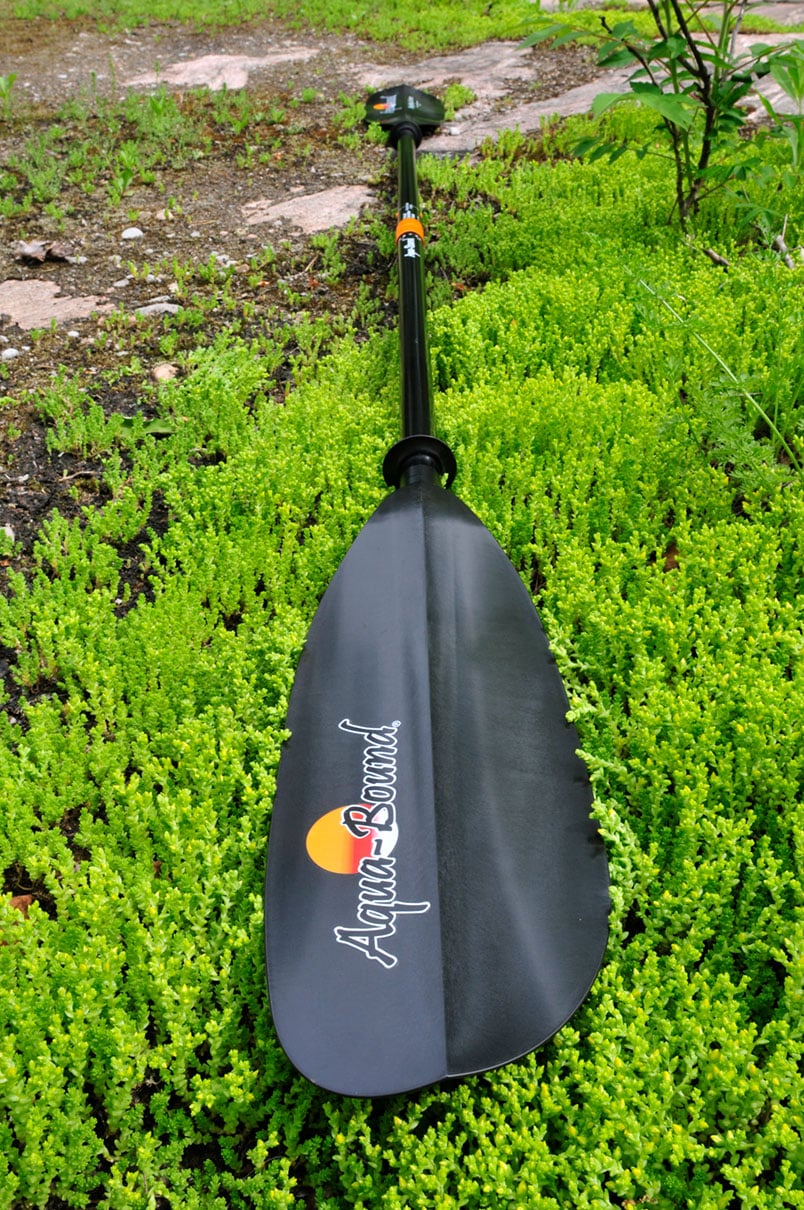
Wing-shaped blade
The wing blade is designed with a deeply-concave, scooped power face, with the ability to increase the efficiency and power of a forward stroke. As the name wing suggests, these blades work by using the “lift” of the Bernoulli effect, similar to an airplane.
Wing blades are often used by competitive racers and may be uncomfortable for the recreational paddler who prefers more mellow, low-angle strokes. A number of experienced touring paddlers also enjoy the benefits provided by wing paddles, especially when you spend most of the day hammering away in a consistent heading.
Greenland paddles
Greenland paddles look nothing like other paddles you will find on the market. The slim wooden paddles used for centuries in Greenland are narrow and shaped like an airplane propeller. Their surface area spread across most of the paddle, instead of just at the ends. They are less common on store shelves but enjoyed for touring.
Advocates of this style of paddle like the high cadence that can be achieved, and the natural buoyancy of the paddle can make rolling a lot easier as the paddle rises to the surface of the water. If you are paddling in super choppy water however or using a lot of quick bracing or sculling strokes, you may prefer some of the wider blades described above to provide more control.
Additional factors for choosing a kayak paddle
Construction materials
Kayak paddles can have shafts made of everything from aluminum, composites, or wood, and paddle blades can be made of plastics, composites, or wood. Why all these differences? They all provide different attributes and, with it, various costs.
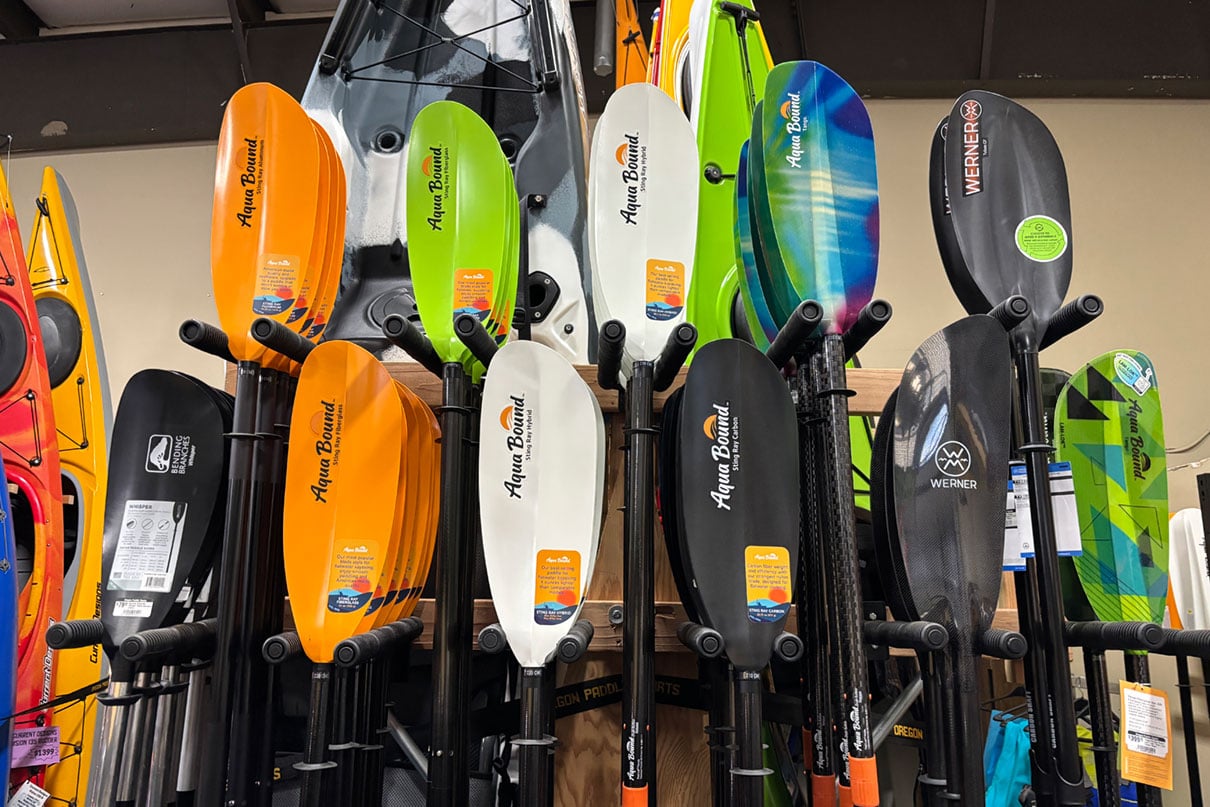
Aluminum shafts
Aluminum paddle shafts fall at the lower end of the price and quality spectrum, and are often combined with plastic blades. They are cheap and can take a beating, making them a reasonable purchase if you are just getting into kayaking or need something to use once in a while. They are heavier though, and the shafts can flex and get bent. Aluminum shafts are usually attached to plastic blades.
Plastic blades
Plastic paddles are quite common due to their low cost. They can be made from various types of plastics including nylon or ABS, and are often attached to an aluminum or fiberglass paddle shaft.
Plastic paddles can vary in durability and performance, and often weigh a little more than composites. Some have more flex, which usually makes them more durable, but if they flex too much, this also equates to less effective paddle strokes. Other plastic blade have little flex, and can be more prone to break if the paddle takes a strike against rocks or becomes wedged between objects. Plastic blades are sometimes reinforced with composites, and these will provide more strength and stiffness than plastic alone.
Plastic blades are affordable and available at just about any store carrying kayaks. They are a good option for recreational paddlers, those storing a casually used boat at the cabin, short day trips or as a spare.
Fiberglass paddles
Fiberglass kayak paddles fairly light, and stiffer and more durable than plastic. Both the blades and shaft of paddles can be constructed of fiberglass. There are also mixed constructions, such as fiberglass blades with a carbon shaft. Mixed constructions provide a negotiation of cost and material characteristics. Fiberglass is a popular choice for kayakers, and there are plenty of paddlers who have the same fiberglass paddle they bought decades ago.
Fiberglass also provides a level of flex under strain that paddlers appreciate. The flex provides a bit of absorption and rebounds back to shape. Making it durable and taking some of the strain off your strokes.
Carbon fiber paddles
Carbon fiber is the most expensive and highest-quality material for a kayak paddle. Many experienced paddlers, especially in touring and whitewater, weigh the choice between carbon and fiberglass.
Carbon fiber is extremely light, and stiffer than fiberglass at a similar layup. The downside of carbon fiber, other than higher cost, is with its rigidness it is more brittle than fiberglass and sooner to reach a breaking point. This means you have to paddle with more care. The rigidity also equates to more strain on the paddler.
For high performance, the stiffness of carbon equates to the highest degree of energy transfer from paddler to water.
Wooden paddles
Those who prefer using a wooden kayak paddle love the increased flexibility, warmth and aesthetic. Compared to the above materials, wooden paddles do need a bit of upkeep, like sanding and varnishing. They can vary in weight, flex, price and other attributes depending on the kind of wood used. They are less common in stores these days, but you may find some options in your paddle shop or even a local builder.
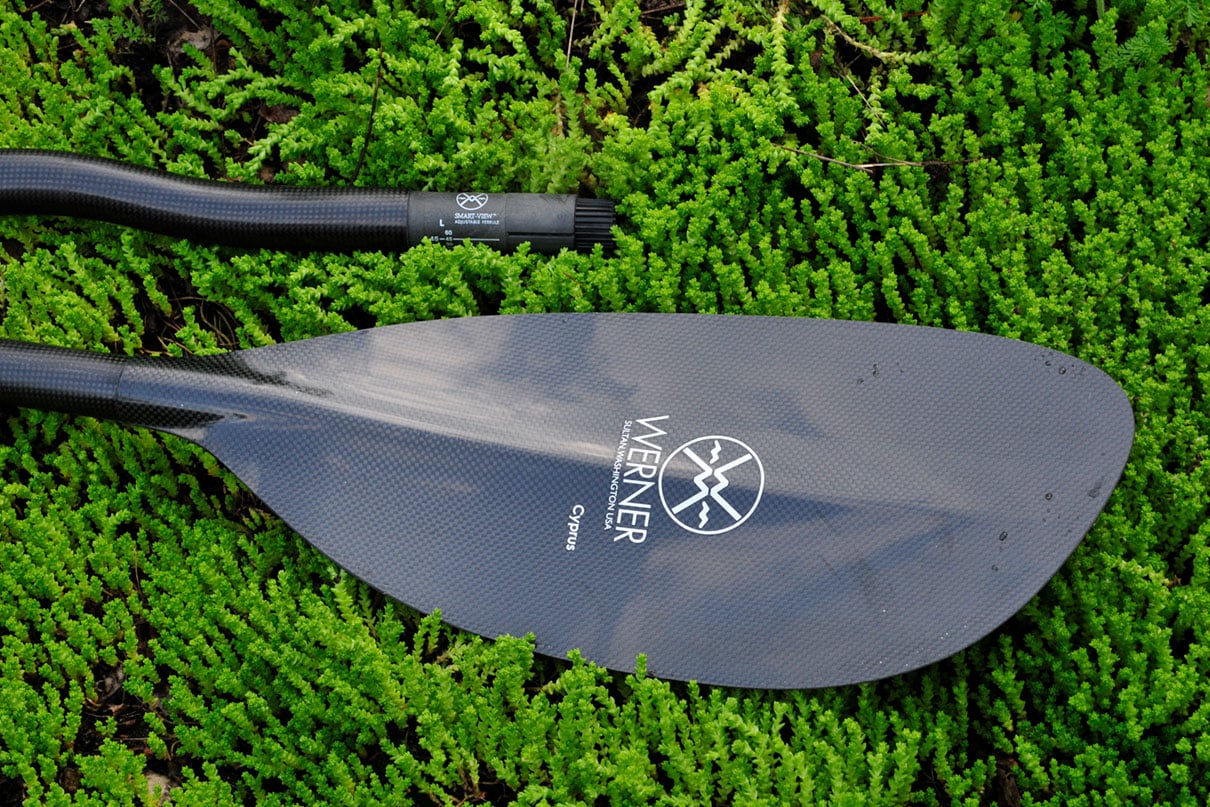
One-piece or two-/multi-piece
You’ll notice there are one-piece or multi-piece kayak paddles available. There are pros and cons to both options, especially as multi-piece paddles increase in quality.
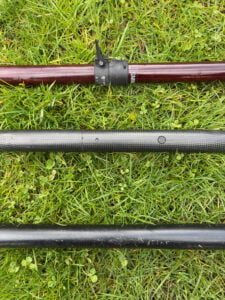
The main positive of a one-piece paddle is its solid construction, with blades and shaft securely glued together. This makes for a well-constructed paddle less prone to mechanical failure and without any wobbling or loose parts to paddle effectively without distraction. One-piece paddles however, are rarely adjustable. So whatever length and feather (explained in a moment) you buy it at, is what you have.
Multi-piece paddles often come as either two or four pieces. Multi-piece paddles used to be considered at the lower end of quality compared to a one-piece, but this has changed, especially for two-piece paddles. Today there are both the budget-friendly and the high performing versions. A breakdown paddle can be a good option for storage and transport purposes or to stow away as a spare.
The biggest positive to a multi-piece paddle is the adjustability they generally include. This can be multiple options of feather angle, or even a range of lengths you can use. The biggest negative is each joint marks a weak point, and the cheapest options will not be as sturdy as a one-piece.
Two-piece paddles join at their center by varying types of locking ferrule mechanisms ranging from buttons to levers. You can find both budget-friendly breakdown paddles as well as high-end ones—and the paddle materials and type of joints used will correspond with the cost. Some of the cheapest paddles available are two-piece aluminum shafts with metal buttons. And some of the most expensive are two-piece carbon builds with lever locks used by Olympic athletes.
Four-piece paddles tend to be used as options to pack down as small as possible. They may be chosen by paddlers using folding kayaks or packrafts—where packability is priority one, or to put in the back of any kayak as a spare.
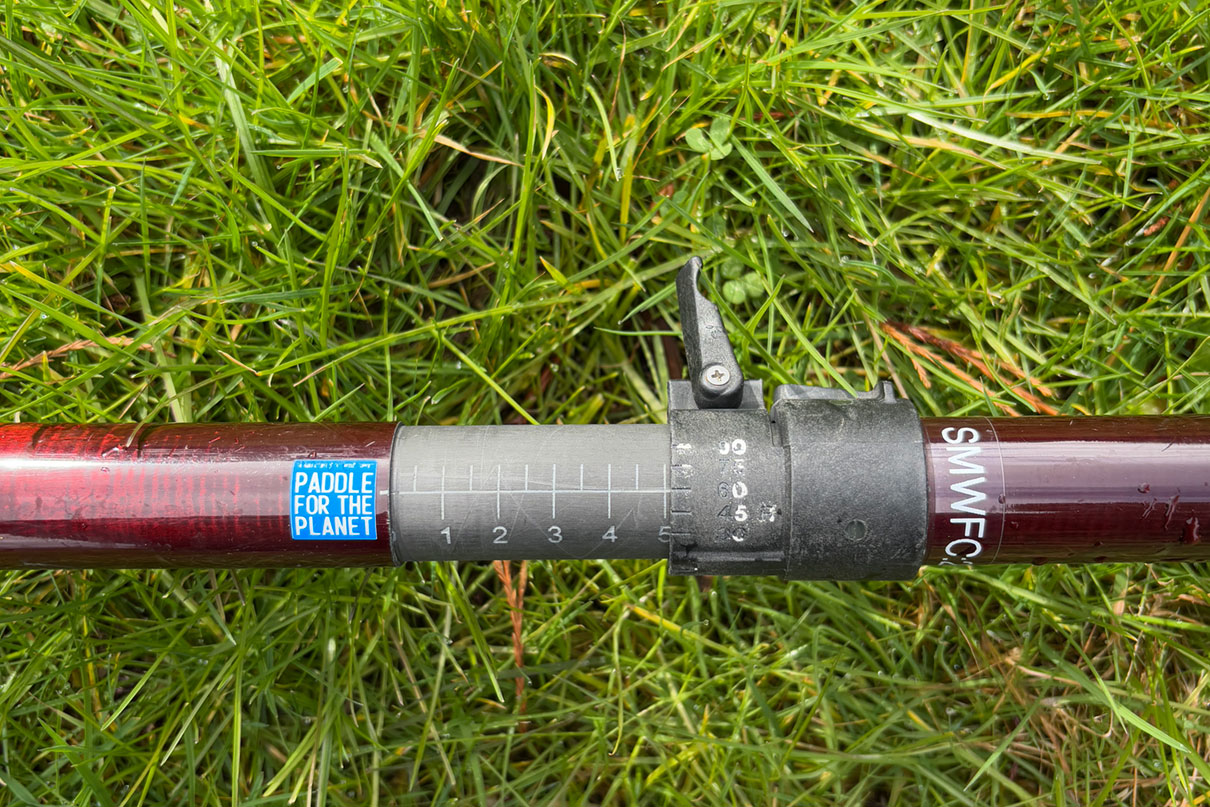
Paddle feather—also known as offset
So what’s the deal with this feathering we’ve been going on about? Feathering on a kayak paddle refers to the angle of the two blades in alignment with one another.
Some paddles have blades in complete alignment with one another, and others are feathered or offset. Why would the manufacturers of kayak paddles do something so deranged as put a twist in the kayak paddle? The simplest answer is to decrease resistance of wind on the paddle blade that is out of the water.
One-piece paddles are set permanently at a specific offset or feather. While many of the multi-piece paddles are adjustable to provide varying degrees of feather, and even adjust for left- or right-handed paddlers.
Beginner paddlers or those with a casual paddling style may find it easier to use a paddle with no or 0-degree feather. Similarly, many whitewater paddlers now use 0 degrees or somewhere between 10 to 45 degrees of feather because they do not deal with as much headwind, and less offset feels more natural during dynamic strokes and rolling. While touring kayakers, crossing open waters with high-angle paddle strokes, often use 45- all the way to 90-degree offset to cut through strong winds.
One of the reasons using a feathered paddle can be awkward is because it requires rotating your dominant wrist from one stroke to the next. This feels unnatural at first, but soon becomes an unconscious act. Some people with wrist alignments may find this painful, and may prefer a paddle without feather. But this can also be alleviated by loosening your grip—like taking your pinkies off the paddle—or by choosing the neutralizing effect of a bent shaft.
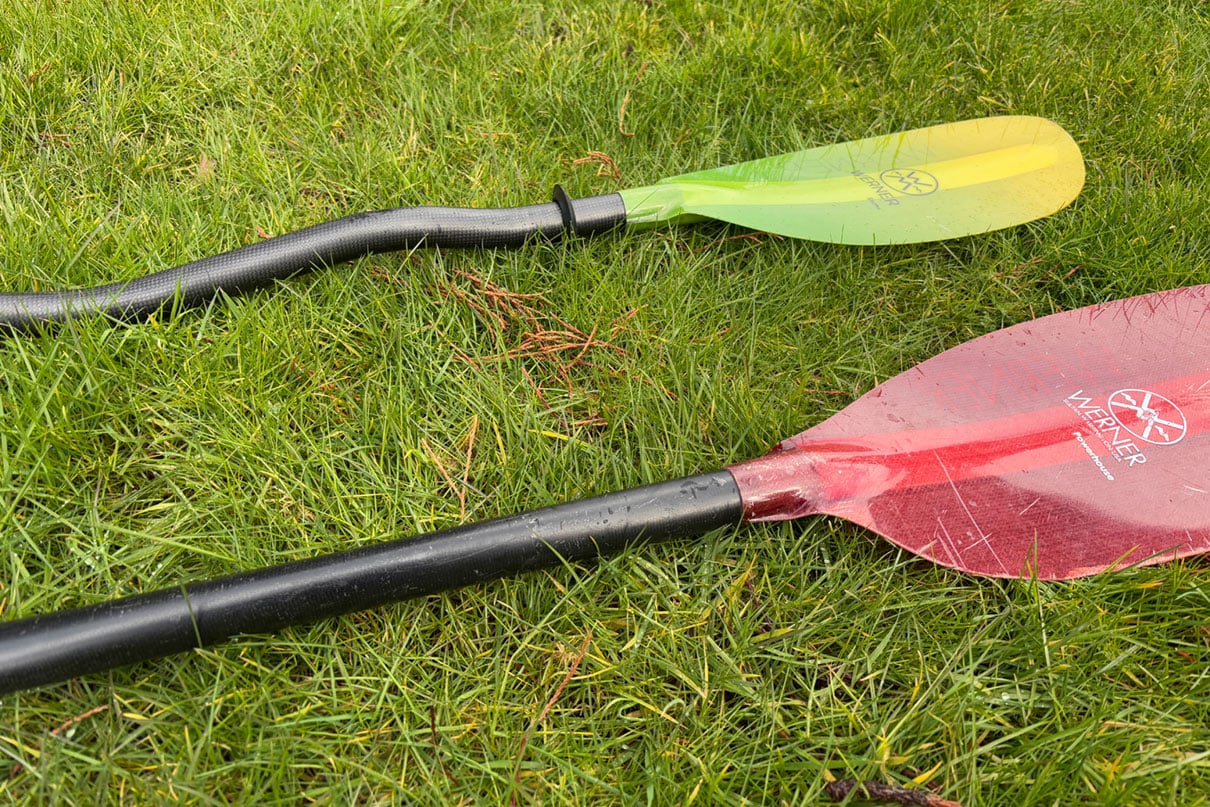
Bent and straight shaft paddles
The majority of kayak paddles have straight shafts, but some have an option called a bent shaft. The intention of these bent sections is to let your wrists stay in a more neutral position while you paddle.
Although they are frequently pricier, for those who are kayaking for long distances or are prone to wrist pain and strain, a bent kayak paddle shaft can be a worthy investment. It’s a personal preference.
A few more options for kayak paddles
- Each kayak paddle company largely has a standardized diameter shaft, however more have started offering smaller shaft options which are less fatiguing to hold and can be especially helpful if you have a smaller hand size.
- Kayak blade designs are often offered in multiple sizes, and similar to height, these tend to be recommended for the size or strength of the paddler. Using a smaller to mid-size paddle blade while you are learning, regardless of your size or strength, helps build good technique and reduces strain and fatigue. Follow the guidelines of each brand’s blade sizes, and if in doubt, you’ll likely benefit from choosing the smaller blade option recommended.
- If a kayak blade is described as dihedral, it means from a geometric standpoint the paddle technically has two power faces. If you hold a paddle straight out in front of you and look at the shape of the blade, a dihedral one will have a ridge at the center with two faces sloping slightly down from the middle The intention of this design is to minimize flutter or vibration during the stroke and allow your blade to better catch the water.
- Some high-end carbon kayak paddles have a foam core blade. This means underneath the carbon layers is a foam material similar to the core of a surfboard. This allows the blade to have more volume and buoyancy without added layers of carbon, which some paddlers appreciate for performance. However, the tradeoff is the thin carbon layup can be dinged if your blade punches a rock.
Kayaker with a low-angle paddle on Georgian Bay. | Feature photo: Nicholas Spooner-Rodie


